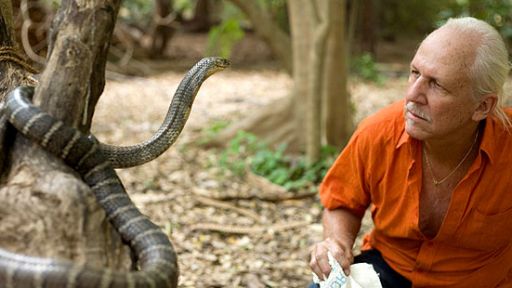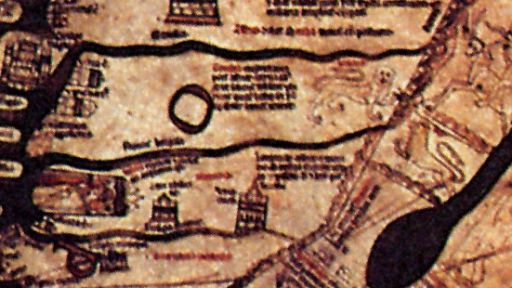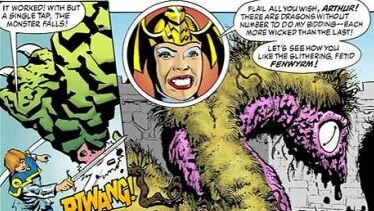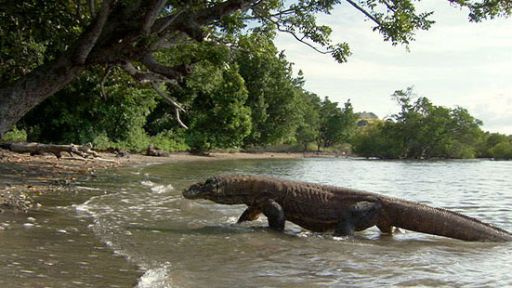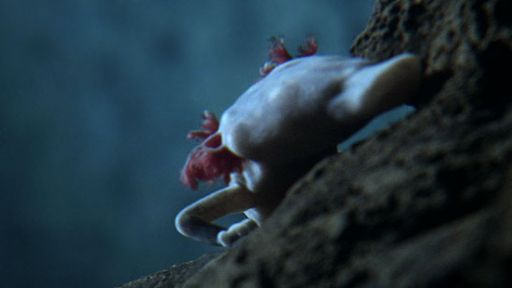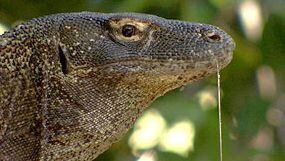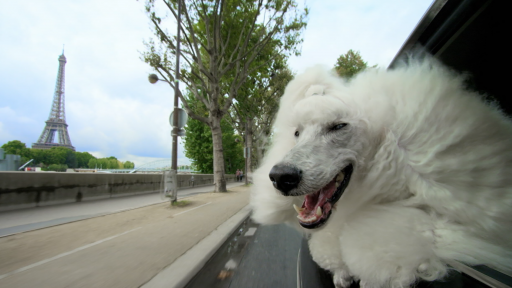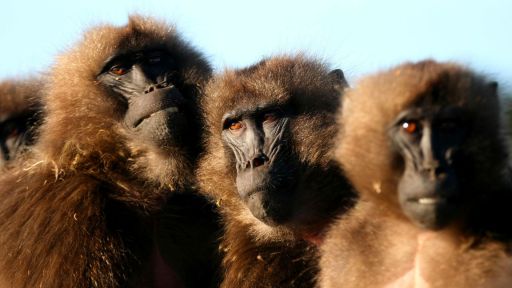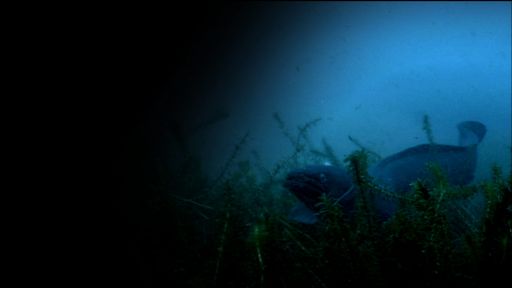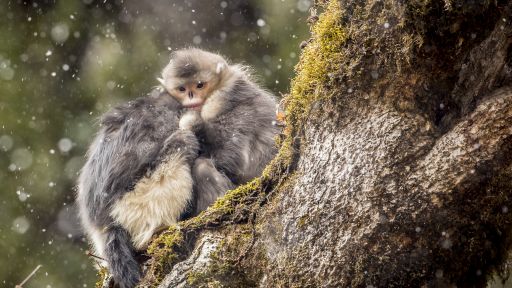TRANSCRIPT
[uplifting trumpeting music] [enchanted music] - [Narrator] Rom Whitaker is one of the world's top reptile experts.
He has traveled the globe studying snakes, lizards, and crocodiles for over 50 years.
And after all this time, there is still one creature that fascinates him beyond all others.
[water splashes] He may never have seen one in the flesh, but it's there in every reptile he studies.
For Rom, it's the King of the Reptiles, the animal that symbolizes nature's most amazing adaptations and magical abilities.
- It's the dragon.
[thunder crashes] And I'm on a quest to track one down.
[upbeat drumming music] [mysterious music] [cheerful upbeat music] [elephant trumpets] ♪ Oh, oh, oh, oh ♪ ♪ Oh, oh, oh ♪ [water splashes] [cheerful upbeat music continues] [relaxing music] - You know this little Godzilla, I made when I was four years old.
My mother saved it all these years.
In fact, it's an antique now.
[laughs] You can see what a strange little mind I had in those days, and I haven't really changed much.
The passion is still there.
- [Narrator] This passion has led Rom Whitaker to a life's work conserving and breeding reptiles in the wild and at Rom's Snake Park and Crocodile Bank in India.
[Rom laughs] As a Herpetologist, the fantastic dragons of his childhood dreams have been replaced by real creatures.
But the more he has learned about reptiles, the more Rom is convinced that reality is always stranger than fiction.
- You know, I've been doing this all my life.
Well, something similar to this.
Playing around with snakes, playing around with lizards, playing around with nice crocodiles like this.
But dragons, well, everyone knows about dragons.
They can fly, they spit fire, they live forever, they guard gold in caves, treasures, they eat people, especially maidens, and they're occasionally slayed by one hero or the other.
And you may or may not believe in all their attributes, supposed attributes, but I think I can find all their qualities for real in my world, my world of reptiles.
[mysterious music] - [Narrator] Hereford Cathedral, deep in the English countryside, may seem like a strange place for Rom to start his journey.
But Hereford has an ancient map that's a dragon hunter's dream.
- This is Mappa Mundi, an incredible Medieval map painted on an animal skin.
For being so old, it's still a lot of features are very familiar.
There's the Nile River here, the Ganges River up there, Jerusalem right in the center here.
The United Kingdom is way down here.
The Red Sea and Ceylon are up in that corner there.
So it's a pretty far out map, but to me, the most evocative part of it are the creatures, the animals.
There's a griffin, there's a Minotaur, there's a winged serpent, and of course, there are very, very dragon-like creatures.
[singing in foreign language] - [Narrator] As a scientist, Rom knows far more about real reptiles than the map makers of yore and their superstitious chronicles.
But he still believes there are dragons at large in the natural world.
[singing in foreign language] - [Narrator] The opening chapter of his quest is, "The Chronicle of the Man-Eating Dragon."
Perhaps the most famous dragon story of all is an archetypal myth that is set in Africa.
Once upon a time, a dragon settled in by a lake and terrorized all who lived nearby.
Only live human offerings appeased it.
Eventually, it was the turn of the king's daughter.
But before she was devoured, a hero arrived, did battle with a beast, and slew it with his lance.
Like all archetypal myths, some elements still rings true to modern ears, particularly to a Herpetologist.
St. George, the Turkish born hero, was based on a real historical figure.
And as for his dragon, there's one obvious contender, the Nile crocodile.
- This is great.
It rained last night and the water's pouring down here.
And obviously, the concentration of birds and crocs is because all the fish have been washed down.
But the crocs are out basking as well.
So there's some feeding, some basking.
They're all around me.
[laughs] There's one basking with his mouth open over there.
Classic.
Some really big ones.
- [Narrator] The biggest Nile crocs are giants.
They can grow up to 20 feet and weigh a ton.
And they're fast, swimming and even running at speeds of up to 10 miles an hour.
With more than 60 teeth, they can devour half their body weight in a single feeding.
But what makes this creature truly dragon-like is that each year, these crocs are reported to kill more than 100 people.
[insects buzz] They are worthy adversaries indeed, but Rom is not out to slay dragons, just to track them.
Back to their very beginnings.
[soft dramatic music] The second chapter of Rom's quest is taking him deep into the heart of all Europe and "The Chronicle of the Dragon's Lair."
[bell rings] Ljubljana, Slovenia, a land of lofty mountains, dense forests, and dark fairy tales.
[ethereal music] - Dragons are deeply ingrained here.
In fact, it's the symbol of Ljubljana.
They're everywhere.
- [Narrator] Although Slovenia's capital may be crawling with dragons, as everyone knows a dragon's lair itself needs to be deep within the bowels of the Earth.
Fortunately, this country has some of the world's finest dragon real estate here in the Postojna cave system.
[ethereal music continues] These caves are not only natural Gothic cathedrals, they are known as the birthplace of speleobiology, the science of cave life.
[ethereal music continues] There's a menagerie of most peculiar animals living in the inky blackness.
[water splashes] And perhaps the most bizarre is what locals in the past believed was a baby dragon.
Like a Medieval knight, Rom prepares to enter the dragon's realm.
[Rom breathes deeply] [zipper creaks] - This is the modern version of dragon hunter's armor to protect me from the cold.
- [Narrator] Even through full armor, the chill of a Slovenian cave pool is quick to numb the senses.
[enchanted music] But soon out of the gloom, strange visions begin to take shape.
[ethereal music] Rom has spent a lifetime scouring the planet for the weird and the wonderful, but this is something even he has never seen before.
No one knows how many of these creatures exist, but they are only found in caves in this small corner of Europe.
The baby dragon in this watery lair is in fact a blind salamander known as the Proteus or the Olm.
[water splashes] - Okay, this is it.
This is the Olm.
Look at this creature.
- [Narrator] The Olm looks like almost nothing else on the planet.
Living in perpetual darkness, it has lost its eyes and its pigment.
As it matures, it retains its juvenile form into adulthood like an enchanted frog trapped inside a tad pole's body.
- It's got legs, but amazingly enough, only two toes on the hind feet, three toes on the front feet.
When you think about the creature and its natural history, what's known about it now, it's just as far out as the idea of it being a baby dragon.
This is a creature that can live for 60 years, maybe even 100 years.
It's a creature that can go without food for 6 to 10 years, and with a very, very low metabolic rate.
- [Narrator] And to the imaginative Medieval mind, this baby dragon could even have wings, or at least external gills, bright red with oxygen-rich blood.
[ethereal music] - As far as the tree of life is concerned, this creature is very, very much out on the edge.
He's out, way out, on a limb.
- [Narrator] The Olm might not be the biggest creature in the world, and it's not even a reptile, but dragon is a state of mind.
And its long fasts put Rom in mind of dragons waking from eons of slumber, famished and dangerous.
But however dangerous a hungry dragon might be, it's nothing compared to the wrath of a dragon whose lair has been plundered.
Rom's quest heads east to India and, "The Chronicle of the Dragon's Hoard."
[mysterious music] As readers of "The Hobbit" know, Bilbo Baggins' dragon, Smog, doesn't just live in a cave, he guards the cave's vast horde of treasure.
Rom grew up with old Indian tales about the lengths to which wealthy Maharajas would go to protect their riches.
With thieves and villains everywhere, the prince's turn to deadly kings for help.
With unblinking eyes, the King cobra is as vigilant as any dragon, capable of killing a man with a single bite.
[soft dramatic music] But for Rom, this treasure is too much to resist.
[cobra hisses] Forget the gold.
He's after the cobra.
This is India Jones, not Indiana.
[cobra hisses] Yet it's easy to see how this mighty serpent could strike fear into a lesser heart.
- People are understandably very, very frightened of venomous snakes.
And I mean, getting bitten by a snake and then seeing someone dying, it's like a bolt from the blue.
And just consider the fact that a King cobra can grow to 18 feet long, producing seven milliliters of venom, enough venom to kill an elephant or a couple of dozen puny human beings.
[laughs] [cobra hisses] - [Narrator] Rom has been lucky enough to survive several venomous snake bites.
But in the process, he's developed an allergy to modern antivenom.
A bite from this snake would almost certainly be fatal.
Venom is just a step away from fire and leads Rom into the next chapter of his quest, "The Chronicle of the Fire Breathing Dragon."
[cobra hisses] [upbeat drumming music] If you're unfortunate enough to be on the receiving end of its strike, this Indonesian spitting cobra does indeed spew fire.
It may be smaller than its Indian cousin, but it makes up for it with some serious attitude.
Not content to deliver its lethal venom in a bite, it's developed a technique for spraying it directly into the eyes of any potential adversary.
[cobra hisses] - Man, this is the ultimate defense.
If I was a mongoose, I'd be running the other direction really fast.
This snake doesn't have to get any closer than this to the mongoose.
He sprays it in the eyes and it hurts like heck.
I mean, it's like getting soap in your eyes times 10.
So the mongoose races in the other direction to clean his eyes out.
The way a spitting cobra can do this is by having a venom which is very fluid.
It's not as viscous as the venom of an ordinary cobra so that it flows through the air like a spray gun.
And this probably means that the venom of a spitting cobra isn't as toxic as the very viscous concentrated venom of another cobra.
But I'm not gonna try it out, of course.
[cobra hisses] It's found all the way, well, over much of Asia, and several species are found in Africa.
It's a pretty common snake.
[cobra hisses] [cobra hisses] [leaves rustle] - [Narrator] In Rom's lifelong love affair with snakes, it's not just cobras that resonate with dragon-like qualities.
Unlike the winged lizards of the West, Eastern dragons are often depicted as enormous serpents.
[soft dramatic music] This is the reticulated python, the longest snake on Earth.
- If I was a deer or a wild boar, I'd be in serious trouble at this point.
This is one big, big snake.
- [Narrator] The Roman naturalist Pliny describes an Indian dragon as so enormous that it could envelope an elephant in its coils.
Accounting for a little embellishment, he may well have been talking about this python.
- This is a python which grows to close to 30 feet long.
And our female here is close to 20 feet long.
They have a fearsome reputation.
In fact, reticulated pythons have actually swallowed human beings.
And, well, this one could certainly take me down, maybe not swallow me, but certainly could suffocate me to death if she wanted to.
She is strong and also one of the most gorgeous snakes in the world.
Look at that.
I mean, she is totally beautiful.
- [Narrator] Real and imaginary serpents and dragons may dance deep within the human psyche.
The almost universal fear of snakes may have a hereditary component.
An aversion to snakes would have helped our early ancestors stay alive.
[snake hisses] [monkey chatters] [snake hisses] And our modern monkey cousins also display a fear of snakes that may be hardwired.
[monkey chatters] [monkey chatters] [monkey chatters] Rom thinks an attraction to fear may partly explain his passion for snakes.
- When I was a young whipper snapper, one of the first things that I really recall very, very strongly is going to the New York Natural History Museum and seeing those giant dinosaur skeletons and my fertile imagination went soaring into space, and it was kind of love at first sight in a strange way.
And I can't speak for all the other kids in the world, but I do know that there is this universal fascination, maybe fear, but certainly a fascination for something dragon-like, some giant reptile, be it a snake or a be it a huge lizard.
[birds chirp] There's one thing you can say for certain.
There is no neutral attitude toward reptiles.
Anywhere you go in the world, people are either fascinated by them or absolutely scared out of their wits of reptiles.
That includes snakes and to some degree lizards too, because in the psyche, in the mind, the lizard could be that dragon, could be that dragon in your dreams.
[leaves rustle] [soft mysterious music] - [Narrator] There's more to dragons than hoarding gold, devouring maidens, and fighting with fire.
[cobra hisses] The serpents and dragons of the East are known for their wisdom.
Even the dragon Smog was fond of a riddle.
Rom believes he can find a creature of flesh and blood to match the legendary cunning of these mythical beasts.
[enchanted music] His quest takes him to Sri Lanka for, "The Chronicle of the Wise Dragon."
[water ripples] Intelligence and adaptability are two keys to success, especially where territory has been shared for centuries with multitudes of people.
Here in the suburbs of Sri Lanka, water monitors have not only survived in society, they've become an essential cleanup crew.
[cheerful music] By night, they still seek the safety of undisturbed mangrove swamps.
But as they wake with the heat of the morning, they make the short commute across the river to earn their keep at the fish docks.
[engine rumbling] Where human development has diminished their usual prey of small fish and mammals, the monitor has been quick to learn that human presence isn't all bad news.
Each morning, instead of heading out to hunt, they wait in line for their daily handout.
[water splashes] [horns honk] [insects buzz] - We've got 10 large adult water monitor lizards here.
They probably weigh on the average about 50 pounds each.
So you've got about 1/4 of a ton of water monitor lizards a couple of yards away from the main highway on the West Coast of Sri Lanka here.
I don't particularly agree with the idea of polluting the river, but these are the scavengers who clean it up.
You know, Sri Lanka is kind of weird in the sense that they don't have any vultures here, no vultures at all.
So these guys play a role in the river anyway, of cleaning the place up.
[water splashes] - [Narrator] Adaptive scavenging behavior like this is more often seen in mammals than in reptiles.
But for Rom, this lizard is so smart, it almost transcends its cold-blooded heritage.
- Whenever I've watched water monitor lizards, to me, of all the reptiles, these are sort of the most mammalian, you know?
The kind of reptiles that we can really identify with because they have that curiosity.
There's one licking my leg right now.
They have that opportunism.
They're kinda like a reptile mongoose, if you put it that way.
And no other reptile seems to have the kind of intelligence or awareness or alertness that these reptiles have.
This is very unlike most reptiles who are much slower, laid back, and sort of glazy eyed.
Do you know what I mean?
- [Narrator] Monitor lizards have been reported to cooperate with each other in foraging by luring crocodiles away from their nests so they can steal their eggs.
And feeding studies have shown that one species is even able to distinguish numbers up to six.
In effect it can count.
[dramatic drumming] [water splashes] But smarts alone don't make a dragon.
You need a bit of ferocity too.
[water splashes] [upbeat drumming] [water splashes] With a little imagination and some oil paint, right here in Sri Lanka there is all the horror of a Medieval dragon.
[crickets chirp] The water monitor is still a predator at heart.
Where dragons of yore may have demanded fleshy sacrifices, today's clever monitor is more practical in its expectations.
[rooster crows] And here in Sri Lanka, instead of a fox in your hen house, beware the giant lizard.
[soft mysterious music] - I'm literally nose-to-nose with a 7 1/2 foot water monitor lizard.
I knew about this guy because he's a regular visitor to this yard.
They keep chickens here and he keeps visiting in the hopes of getting one.
In fact, he occasionally does get one.
He's a well known citizen of this area.
- [Narrator] When water monitors approach their full size, they seem to throw off another one of their reptilian constraints.
- A big lizard like this doesn't have to bask in the Sun in the morning to be warm.
Whatever heat he gained the day before, he's ready to go early in the morning.
A small lizard has to bask first before it can rev up and get going.
- [Narrator] Free from the reptilian need for constant thermal regulation, the water monitor becomes a much more effective predator and a more dangerous subject for a close-up.
- I'm kind of worried about that tail though.
[laughs] If he bends it back the other way, I'm gone.
[laughs] The slap in the face wouldn't be good.
[water splashes] - [Narrator] Whether hunting or foraging, the water monitor's keen intelligence is matched by an equally sharp sense of smell.
- Everything a water monitor does seems to be guided by smell.
Whether it's finding food or finding a mate, that fork tongue works the same way a snake's fork tongue does.
There's something called Jacobson's organs in the roof of their mouth and they pick up particles of scent from the air and from whatever they're looking at and smelling, and it delivers it right to the roof of the mouth.
That's what he's doing now.
He's smelling what I've got, but he's a little wary of me.
He's not quite sure about my intentions here.
- [Narrator] When dealing with an adversary too big for its teeth, the water monitor employs its next most effective weapon.
[water splashes] - And that's his main defense, if he wants to.
[water splashes] He can give me a good whack with his tail.
Smarts.
[water splashes] Better sort of keep back from it.
[water splashes] Hey!
This whole tail lashing is just simply his way of trying to see me off.
I mean, that's a real, real good, very, very effective defensive whip.
And it hurts.
It really smarts.
I don't know why he's being so nasty to me.
Here I am feeding him.
I mean, come on guy.
- [Narrator] Every dragon hunter bears his scars.
[water splashes] - He's big- Oh!
Ah!
- [Narrator] And here in Sri Lanka, Rom's picked up another to add to his list.
Dragons are complex beasts, part myth, part science, part dinosaur fantasy.
But whatever the inspiration, one thing all dragons must do is fly.
Rom is going to prove that anything fiction can do, fact can too.
This is, "The Chronicle of the Flying Dragon."
- Probably the most famous flying reptile that ever existed was the pterodactyl.
Back in the dinosaur days, a massive leathery-winged flying creature that sort of gave us all the creeps when we were little kids.
- [Narrator] Pterodactyls may be extinct, but for Rom, their dragon-like relatives still cast their shadow upon the Earth.
And he's come to the rainforests of India's Western Ghats to catch one.
It's known to modern science as Draco dussumieri.
- Oh man.
[soft dramatic music] Your whole perception of the rainforest changes every level you go up.
It's in tiers.
And now I'm above the sort of the lower story getting up toward the canopy and there's something different sort of every step of the way.
So this is dragon country, flying dragon country.
There's a male over there.
Look, look, look.
Dewlap.
If I take some time and look around.
There's another.
It's a female.
They're all at this level.
50, 60, maybe even 70 feet up in the canopy on the open sunlight.
It's just hitting those trees over there.
Just the right time of day and they're heating up.
Oh, it's brilliant to see them at eye level like this.
Absolutely brilliant.
- [Narrator] There are over 20 different species of Draco found throughout tropical Asia.
They spend practically their whole lives high up in the canopy.
There are no maidens up here.
They feast on the ants that share their treetop home.
[birds chirp] When threatening rivals or attracting a mate, the males blow their cover and extend the bright yellow flap on their neck in a display called dewlapping.
[birds chirp] The view may be great up here, but Rom's natural dragon hunter's agility is somewhat hampered by ropes and harnesses.
To actually catch one of these dragons, he is going to need a new weapon.
A lance with slight modifications.
[tool clangs] The Greek historian Herodotus describes throngs of winged serpents guarding trees in Arabia.
Scholars have long argued over what exactly he was describing.
Rom's got his own theory.
This plantation is thousands of miles from Arabia, but it is swarming with Draco.
And the male does indeed guard the trees of its home territory from other encroaching males.
But when faced with a dragon hunter's lance, its main form of defense is evasion.
[upbeat music] It may be only nine inches long and live on a diet of ants, but when Draco has nowhere left to run, it matches its mythical namesake and takes to the sky.
[upbeat music continues] - This side, this side, this side.
Ai!
[upbeat music continues] Okay, little guy.
Quickly.
Quickly.
Gently.
Gently.
Oh, oh, wait, wait, wait, wait, wait, wait.
Okay.
- [Narrator] Rom's perseverance finally pays off.
- Oh, what a beauty.
One amazing lizard.
It's a male for sure.
It's got this huge yellow dewlap.
It's really fragile.
Look at this.
I'm trying to be as gentle as I can with it 'cause it just seems like skin and bones.
And probably most remarkable of all, if you gently stretch it out, got these amazing wings.
Look at that.
The first time I ever saw one of these, I thought a butterfly was floating over me literally.
Then I saw it land on a tree and catch an ant.
That's no butterfly.
[laughs] This is, to me, one of the most remarkable reptiles on the planet.
- [Narrator] And Rom believes Draco's amazing dragon-like abilities wouldn't have been lost on earlier visitors to these regions.
- Back in the days of yore, explorers would go to the deepest, darkest parts of the East Indies.
They'd come back with real drawings of things like rhinoceroses.
This is the first time the civilized world had seen anything like this.
But they'd also come back with amazing fanciful drawings of lizards looking very much like this.
Only they depicted them as 30-foot long flying dragons.
They looked very, very much like what we've got here.
So they really did see some real stuff, but then their minds went a little bit wild and sort of took it to the extreme.
And maybe that's why they called it Draco.
I'm sure that's why they called it Draco.
[upbeat music] - [Narrator] So far, Rom's journey has taken in man-eating crocodiles, cave-dwelling Methuselahs, reptiles that fly and spit fiery venom, [cobra hisses] and fierce lizards as smart as mammals.
Now he seeks a dragon that needs no embellishment or artistic license.
[upbeat enchanted music] The final chronicle is of, "The Real Dragon."
By the 19th century, the idea of dragons roaming the Earth had been dismissed as Medieval superstition and fantasy.
But only 80 years ago, scientific certainty was thrown into disarray with rumors of a remote island that could have come straight from the Mappa Mundi.
It was home to a giant creature never seen by the outside world.
In 1926, the American Museum of Natural History launched an expedition to capture a beast that even science would call a dragon.
For Rom, his first visit to Komodo is the climax of his life's obsession with reptiles.
In his excitement, he too can almost sense the monsters in the landscape.
For a dragon hunter on a crusade, this is the Holy Land.
[upbeat enchanted music continues] - I can just imagine how it must have felt being on that first expedition from the American Museum of Natural History coming to Komodo, all these crazy stories about a giant reptile still wandering around in this kind of landscape.
I mean, actually getting a few shivers thinking about it.
But the idea of finding a big dinosaur-like creature alive in this day and age just blew everyone away.
And then when they got here and actually started wandering around and then came face-to-face with the first really big Komodo dragons.
Ah!
That is true excitement.
I mean, oh man.
We're really looking at a primeval landscape here.
If there was ever a place that deserves to have a dragon, this is definitely it.
[soft mysterious music] - [Narrator] The next morning, Rom's chance to see a living dragon has finally arrived.
His first footfall is like stepping back into a Jurassic past.
[water splashes] Walking through this King Kong landscape, he can't help thinking about the dragon's fearsome ambush abilities and the people who've been killed and eaten on these very islands.
[soft mysterious music continues] [birds chirp] - Oh man.
This is the first time I've ever seen a wild Komodo dragon.
[water laps] We're used to all the different kinds of monitor lizards I've been seeing all over the place, and there's never, there's just not any of them as massive as this creature is.
Here's a real land predator, you know?
Stomping around like a dinosaur, leaving footprints like a dinosaur.
I mean, it's everything I ever expected.
[birds chirp] - [Narrator] Real dragons live within fixed territories and the population where Rom has landed show absolutely no fear of humans.
And for once, after 50 years around large reptiles, it's Rom's turn to show some fear.
[leaves rustle] - Whoa!
What is it?
I didn't do anything.
Whoa!
Whoa!
[footsteps crunch] No, no.
I didn't do anything.
I really didn't.
And I don't have any meat.
No, I don't.
Nothing.
[leaves rustle] Really.
[leaves rustle] There are very few reptiles who will do this!
[birds chirp] Phew!
They say that reptiles get tired real easy.
[laughs] How about humans, man?
Tiring me out.
[leaves rustle] This is scary, you know?
The only time I've ever been chased by a reptile is a female crocodile at her nest.
Not a free-ranging big, big lizard like this.
And from what I understand, it's not just for fun.
If he catches me, if I trip, I'm meat.
- [Narrator] Rom's right to be wary.
As recently as 2007, an eight year old boy was attacked and killed by a Komodo dragon not far from this very spot.
- You know, when I first landed on the beach there, I just wandered around all by myself, you know?
And I wouldn't do that now.
No siree.
[soft dramatic music] - [Narrator] On the few islands they inhabit, these dragons are the top predator.
They can eat 80% of their own body weight in a single meal and are believed to have a sophisticated and sinister technique for killing large prey.
Their saliva is often described as a foul cocktail of virulent bacteria that would turn even the smallest bite into a dangerous festering wound.
This deer has been bitten by a dragon.
It's simply a matter of time before it succumbs to blood poisoning.
And it won't take long for the Komodo dragon and its friends to track it down and then do what they do best.
[dramatic drumming] Many scientists have tried to discover which bacteria makes dragon drool so toxic, another reptilian fiery bite.
Rom wants to get to the bottom of the story.
And to do this, he needs to catch one.
[victorious music] The dragon slayer of yore was the most courageous of knights.
And we've got the modern day equivalents, Komodo expert Jerry Imunsaya, his colleague, Denny Perwondonna, and sometime dragon fanatic Rom Whitaker.
Now enter the dragon.
[leaves rustle] It may have been a stretch from tiny Olm and diminutive Draco to dragon, but here on Komodo, you don't need your imagination.
[footsteps rustle] - [Komodo Expert] Come on.
Try again.
Try to get out.
[speaking in foreign language] [speaking in foreign language] - [Narrator] This may seem an extreme form of capture, but the Komodo researchers have been working with these lizards for many years, and this practice is harmless to the dragon, if not to the researcher.
- Okay.
[speaking in foreign language] - Good.
Good.
[Komodo Expert speaking in foreign language] - Okay.
Got it.
[tape squeaks] That should be good, yeah.
Okay?
- [Komodo Expert] Okay.
- I've caught a lot of crocodiles, but I didn't realize how strong these guys can be.
And he doesn't run out of steam, man.
The croc will sort of, it'll get tired in a few minutes.
And this guy just, oh man, he's endlessly, endlessly strong.
- [Komodo Expert] Okay, sit.
- Now, look at these nails, huh?
It's like a big eagle's claws or something.
- [Narrator] The sharp claws of other Komodo adversaries have left scars all over this animal's armor-plated back.
But it's not just the claws you need to watch out for.
- 60 teeth?
- 60 teeth.
[Rom laughs] Sharp teeth.
- Very sharp teeth.
Someone said they're very much like shark teeth, yeah?
- Yeah.
- Because they have the edge of a knife edge.
Look, he's getting calmer.
- [Narrator] Calmer, he may be, but this is still the largest lizard that Rom has ever handled.
- [Komodo Expert] Make it straight.
- [Rom] Yeah.
- Eight feet and six inch.
- Eight feet, six inches.
Well, the biggest water monitor we ever measured was a little over seven feet, getting close to eight.
This at 8 1/2 feet is getting to amongst the largest size Komodo dragons you can find.
This is one very, very big lizard.
- [Narrator] When it comes to bulk, the Komodo is in a league of its own.
Water monitors can weigh up to 55 pounds.
A 10 foot Komodo can tip the scales at over 360 pounds.
With this dragon tamed, it's time for Rom's experiment.
- And basically what we'd like to do here is to take a sample of its saliva.
Okay.
Ready?
Yeah.
All right.
Oh, that's perfect.
Okay.
It's gonna be very interesting to see what we can culture with this.
Okay, his legs are loose.
Okay.
On your mark.
Get set.
Go!
[footsteps rustle] - [Narrator] The slow metabolism of coldblooded reptiles means that most tire very quickly and take a long time to recover after exertion.
But even after being sat on by Rom, this dragon is up and running right away.
- Look at that.
He's taking the tidbit.
You know that recovery time is like what?
30 seconds?
I have never seen anything like it in my life.
- [Narrator] With offerings made and no hard feelings, off he goes.
A dragon on the prowl.
[birds chirp] Saliva samples in hand, Rom heads for the nearest lab.
It might not be the most conventional, but at least it's safe from hungry dragons.
[soft mysterious music] The next step in his bacteriological study is to obtain a control sample of saliva to compare with the dragon samples.
- Now I'm basically taking a swab of my own saliva.
[Rom heaves] Similar to what I just did with the dragons on shore in order to see if we can get the kind of bacterial growth from both the human being and the dragon.
- [Narrator] The dragon saliva and Rom's own are smeared into different Petri dishes containing nutrients on which bacteria thrive.
- This is not exactly the most sterile situation you can imagine, but we're doing the best we can here.
I should know what I'm doing because way back in the Vietnam War days, I was trained in this stuff as a lab technician.
Man, I took hundreds of swabs and took lots of blood samples from thousands of soldiers.
Actually never thought I'd be doing it with Komodo dragons though.
[laughs] That should do it.
Now they've gotta incubate overnight.
24 hours, we should see something.
- [Narrator] Rom's hoping the samples will blossom into colorful cultures that will prove decisively who's more foul mouthed.
Dragon or dragon hunter?
[insects buzz and chirp] [relaxing music] 24 hours after inoculation, Rom's experiment has come up with some graphic results.
One species of bacteria he's tried to culture from Komodo saliva is Pasteurella multocida, a strain that can kill a human within days of entering the blood.
And this plate looks deadly.
- Look at this growth.
This is absolutely amazing.
It's not the mark of Zorro, this is just the streak that I did.
And you're looking at probably several species of bacteria here, and one of them could very well be Pasteurella.
And this is counted as the most virulent of all the bacteria found in Komodo dragon saliva.
- [Narrator] But the Komodo dragon isn't the only creature out there with potentially deadly drool.
- Looking at the mouth swab from Rom Whitaker are on another kind of media, we're looking at a growth which could very likely be E. Coli.
Now, E. coli is a common bacteria and there are many, many strains, some of them extremely virulent.
And this could very well be one of those.
And in fact, it's already been more or less proven that there are 80 or more different species of bacteria that have been isolated from the human mouth and only 57 from the dragon's mouth.
There's an obvious conclusion here.
You do not want to be bitten by a Komodo dragon, nor do you want to be bitten by Rom Whitaker.
[dramatic drumming] - [Narrator] Rom's experiment has shown that in these tropical conditions, any saliva is a potentially lethal cocktail.
But this doesn't make the Komodo dragon any less formidable.
- I've got a brand new respect for these dragons.
I don't think I really understood or realized what I was gonna meet.
[relaxing enchanted music] To be there, to experience them, is something out of this world.
They have different personalities, that's for sure.
There are some fairly calm ones, some very serious ones.
In fact, so serious that I was definitely on the menu.
There's no doubt of that.
And if we thought we were at the top of the food chain, well, meeting up with a dragon like that, you have to think twice.
I think being a human, being a mammal, we're very, very conscious of this visceral fear we have of being prey.
A tiger, a leopard, one of the big animals which would grab us, toss us around like a rat, ugh, swallow us down.
Taking it to another level, there's something even more primeval about being preyed upon by a reptile.
And be it a giant python, or in this case, a giant lizard on Komodo, there's something that makes you shivery just a little bit.
Even a guy like me who's supposed to know reptiles really well.
- [Narrator] Despite the scientist within, Rom's quest for dragons in the real world has opened his eyes to new possibilities.
He's realized that whatever lies behind his compulsion for reptiles may be the same thing that's made the dragon such an enduring symbol all around the world.
And the story of their powers is still unfolding.
As Rom investigates a nest of freshly hatched dragon eggs, he marvels at what science has just recently discovered.
That dragons have an ability that in humans would be considered miraculous.
- There's a real truly magical quality about the Komodo dragon, and that is that a female can lay viable, fertile eggs without having mated with a male.
And this is a special strategy, a special survival strategy, for the species.
Komodo dragons swim from island to island, and here we are in a maze, almost 18,000 islands in the Indonesian archipelago.
And let's say something happened here.
Let's say a volcano blew up.
And, well, one of the females managed to swim off to another island.
- [Narrator] Now things get interesting.
All alone on a new island, a female Komodo can still lay fertile eggs.
No mate required.
Other lizard females can do this, but they produce only female young.
The Komodo is unique.
She can give birth to her own future mates.
- Once upon a time, a female Komodo dragon washed up on this island here.
Now she was alone, there were no other Komodo dragons there.
But she laid a clutch of eggs and produced five viable offspring.
And they're all males.
Not twins, not clones, genetically distinct males which could, when they matured, mate with the same female.
And she produced more offspring.
In this case, because it was sexual reproduction, she was able to produce males and females.
- [Narrator] Although she is an Eve without an Adam, a new population springs up complete with males and females.
[soft upbeat music] Over time, chances are that a traveling male may find the island and bring new genes into the mix.
The dragons have conquered a new land.
[soft upbeat music continues] For Rom Whitaker, scientist and story lover, the abilities of reptiles continue to astonish and the dragons of myth and legend are alive and well and all around us in the real world.
[cheerful upbeat music] [upbeat music]

